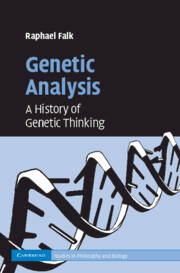Book contents
- Frontmatter
- Contents
- List of figures
- Acknowledgments
- Introduction
- PART I FROM REPRODUCTION AND GENERATION TO HEREDITY
- PART II FAKTOREN IN SEARCH OF MEANING
- 3 From Faktoren to unit characters
- 4 The demise of the unit character
- PART III THE CHROMOSOME THEORY OF INHERITANCE
- PART IV GENES AS THE ATOMS OF HEREDITY
- PART V INCREASING RESOLVING POWER
- PART VI DEDUCING GENES FROM TRAITS, INDUCING TRAITS FROM GENES
- PART VII WHAT IS TRUE FOR E. COLI IS NOT TRUE FOR THE ELEPHANT
- Concluding comments
- Bibliography
- Index
4 - The demise of the unit character
Published online by Cambridge University Press: 07 August 2009
- Frontmatter
- Contents
- List of figures
- Acknowledgments
- Introduction
- PART I FROM REPRODUCTION AND GENERATION TO HEREDITY
- PART II FAKTOREN IN SEARCH OF MEANING
- 3 From Faktoren to unit characters
- 4 The demise of the unit character
- PART III THE CHROMOSOME THEORY OF INHERITANCE
- PART IV GENES AS THE ATOMS OF HEREDITY
- PART V INCREASING RESOLVING POWER
- PART VI DEDUCING GENES FROM TRAITS, INDUCING TRAITS FROM GENES
- PART VII WHAT IS TRUE FOR E. COLI IS NOT TRUE FOR THE ELEPHANT
- Concluding comments
- Bibliography
- Index
Summary
de Vries and Bateson introduced the hybridist analytic methodology to challenge morphogenists' thinking about Darwinian evolution. Asking to what extent could ecologically related continuous variations of local populations become characteristics of distinct taxonomic strains and eventually species, they adopted not only a reductionist, particulate conception of organisms but also a rather determinist notion of the inherent nature of these unit characters. They established Mendelian genetics on determinist foundations in which Faktoren served as preformed unit characters.
Deterministic notions such as Faktoren becoming unit characters were anathema to both natural historians in the field and embryologists in the laboratory. Richard Woltereck's objective was to provide a rejoinder to what he called the Mendelian teaching following Weismann's and de Vries's conception of the origin of species (Woltereck, 1909). In his “investigations on the change of species, with emphasis on quantitative species-specific difference” he showed that when the conditions under which strains of Daphnia species from different lakes in Germany existed were modified, their morphology changed to simulate that of another acknowledged species. Furthermore, each strain had its specific inherent Norm of Reaction, that is, its characteristic morphological response pattern to variation in environmental conditions. Such specific norms of reaction made it meaningless to predict the properties (the form characteristics) of one strain under one set of conditions from those under another set of conditions or from those of another strain under the same conditions (Woltereck, 1909; see also Falk, 2000a).
- Type
- Chapter
- Information
- Genetic AnalysisA History of Genetic Thinking, pp. 58 - 74Publisher: Cambridge University PressPrint publication year: 2009



